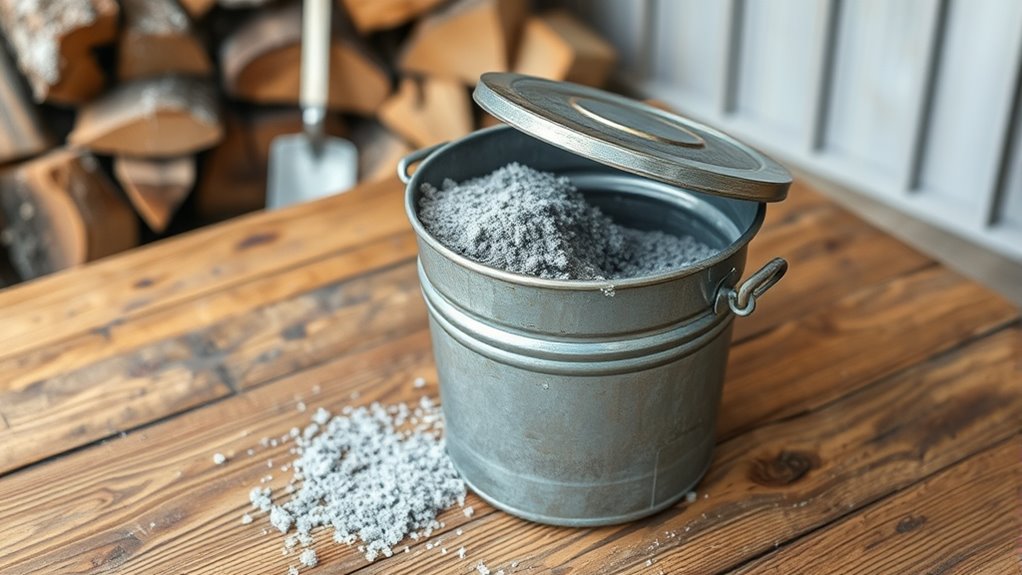When handling wood ash, wear gloves, masks, and goggles to stay safe. Make sure the ash cools completely before disposal or reuse, and store it in fireproof containers away from children and pets. You can recycle ash by mixing it into your soil for added nutrients or using it as a pest deterrent in your garden. To learn effective disposal methods and creative ways to reuse ash while protecting the environment, keep exploring these safe practices.
Key Takeaways
- Always cool ash completely before disposal to prevent fires and dust hazards.
- Store ash in sealed, fireproof containers away from flammable materials and children.
- Use ash as a soil amendment to add minerals, but test soil pH to avoid over-alkalizing.
- Incorporate ash into compost or garden beds carefully, avoiding application on acid-loving plants.
- Follow local regulations for disposal and reuse, and handle ash with protective gear to ensure safety.
Understanding the Composition of Wood Ash

Understanding the composition of wood ash is essential for safe and effective disposal. Wood ash primarily consists of mineral content, including calcium, potassium, magnesium, and trace elements, which influence its properties and potential uses. Its chemical composition varies depending on the type of wood burned and the combustion process, affecting how you handle and reuse the ash. For example, high calcium levels can make ash alkaline, impacting soil acidity if used as fertilizer. Knowing the mineral content helps you determine whether the ash is suitable for garden applications or requires careful disposal. Additionally, being aware of its alkaline nature is important because it can alter soil pH levels, which may be beneficial or detrimental depending on your garden’s needs. The pH level of the ash is a critical factor to consider when applying it to soil, as it influences plant health and soil chemistry. Understanding the chemical composition of wood ash can also help you avoid potential hazards such as excess alkalinity or heavy metal contamination. Recognizing the heavy metal content is crucial for safety, especially if the wood has been treated or painted. Furthermore, the presence of certain trace elements can sometimes be beneficial for soil enrichment, provided they are in safe concentrations. By understanding these components, you can avoid potential hazards and make informed decisions about reuse or disposal, ensuring safety and maximizing benefits from your wood ash.
Safety Precautions When Handling Ash
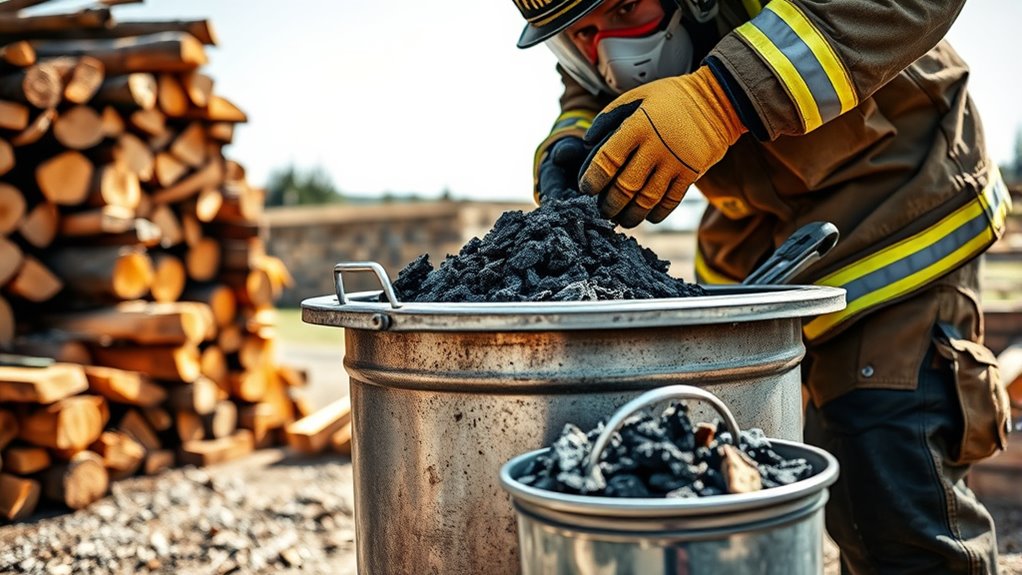
Handling wood ash safely is essential to prevent health risks and property damage. Ash can contain hazardous materials like fine particles and residual chemicals, so always wear protective gear such as gloves, masks, and goggles. A thorough understanding of ash disposal procedures can help prevent accidents and environmental contamination. Avoid inhaling dust or spreading ash in windy conditions. Store ash in metal containers away from flammable materials. Keep children and pets away during handling. Use the table below to guide your safety precautions:
| Precautions | Details |
|---|---|
| Wear protective gear | Gloves, mask, goggles |
| Avoid inhalation | Use masks and handle carefully |
| Store properly | Metal containers, away from flammables |
| Keep area clean | Minimize dust spread |
| Keep others safe | Keep children and pets away |
Additionally, understanding the fire safety procedures can help prevent accidents when disposing of ash. Proper disposal methods also involve ash reuse options that minimize waste and environmental impact.
Proper Disposal Methods for Wood Ash
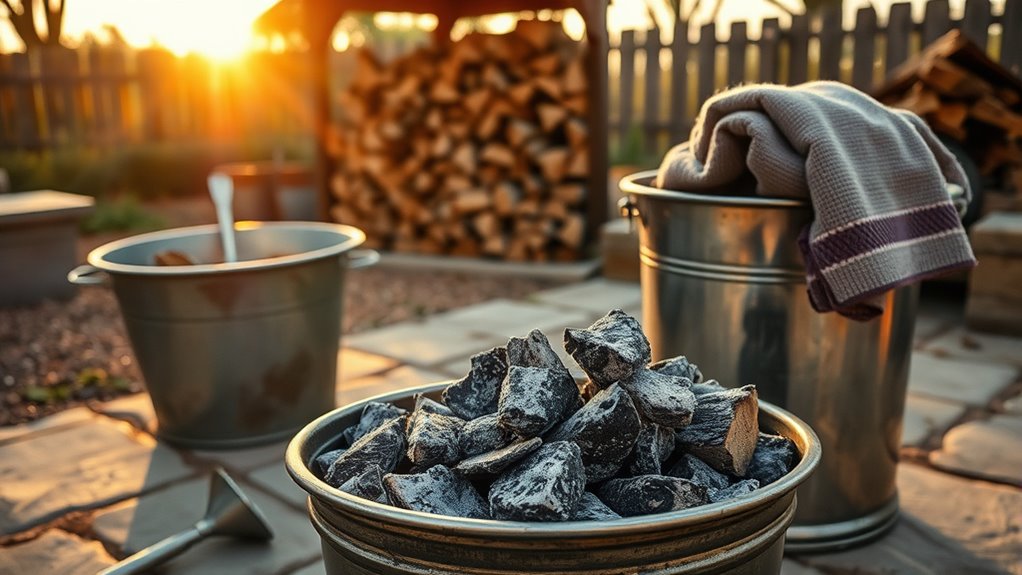
Once you’ve safely collected and stored your wood ash, it’s important to dispose of it properly to prevent environmental harm or fire hazards. Check local ash disposal laws to ensure compliance, as regulations vary by area. Generally, wood ash can be safely disposed of with regular household waste if it’s completely cooled and free of hot spots. Never discard hot ashes into trash cans or near combustible materials. Be aware of hazardous waste regulations, especially if your ash contains chemical-treated wood or contaminants, which require special handling or disposal methods. If unsure, contact your local waste management authority for guidance. Proper disposal minimizes fire risks and environmental impact, helping keep your community safe and compliant with legal standards.
Recycling Ash as a Soil Amendment
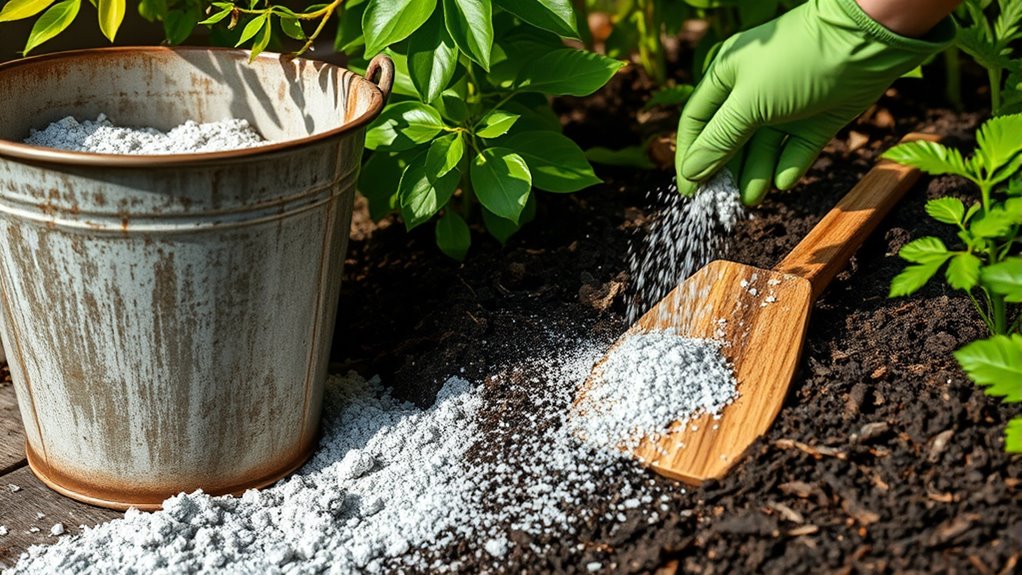
You can recycle wood ash as a soil amendment to enrich your garden, but it’s important to understand its nutrient content first. Applying the right amount helps boost soil pH and adds essential minerals like potassium and calcium. Incorporating soil testing ensures that ash use promotes healthy plant growth without risks to soil or plants. Additionally, integrating AI in Business innovations can streamline how gardeners access information and resources for sustainable practices. Moreover, understanding industry transformations can help gardeners stay informed about new methods and innovations in sustainable practices. Follow these tips to use ash safely and effectively in your gardening routine.
Nutrient Content in Ash
Because wood ash contains essential nutrients, it can be a valuable soil amendment when used responsibly. Its ash nutrient content includes minerals like potassium, calcium, magnesium, and trace elements crucial for plant growth. Conducting a mineral analysis helps determine the specific nutrient levels in your ash, ensuring it benefits your soil without causing imbalances. Understanding this nutrient profile allows you to apply ash appropriately, avoiding excessive alkalinity or nutrient overload. While ash can boost soil fertility, it’s important to remember that its nutrient content varies depending on the wood type and combustion process. Proper testing and moderation help you maximize its advantages while preventing potential soil issues. Using ash as a soil amendment can enhance plant health when you respect its nutrient composition. Additionally, referring to best practices can help you apply ash safely and effectively. Soil health is essential for sustainable gardening and can be improved by mindful ash application.
Application Tips for Gardens
Recycling wood ash as a soil amendment can be highly beneficial if applied correctly. It helps with pH adjustment, making acidic soils more neutral, which benefits many plants. Before adding ash, test your soil’s pH to avoid over-alkalizing. Spread a thin layer of ash evenly over the garden, mixing it into the soil to prevent runoff. Keep in mind that ash can also aid weed suppression by creating a less hospitable environment for weed seeds when used properly. Avoid applying large amounts at once, as excessive ash can harm plants and disrupt soil balance. Use ash sparingly, especially around vegetables and delicate plants. Proper application ensures your garden benefits from the nutrients and pH benefits without risking soil or plant health. Additionally, incorporating water from water parks or aquatic exercises can help hydrate soil and plants during dry periods. Being aware of soil testing methods can further optimize your ash application and garden health. Utilizing knowledge of 16PF traits can also help tailor your gardening approach to your personal strengths and preferences.
Creative Ways to Reuse Wood Ash Around the Home

You can use wood ash to enrich your garden soil, giving your plants a natural boost of nutrients. It also works as a pest control method, helping to repel insects and pests naturally. Exploring these creative uses can help you make the most of wood ash around your home. Additionally, applying wood ash to your soil can improve its pH balance, making it more suitable for various plants soil enrichment. Incorporating wood ash into your garden can also contribute to home decor by enhancing the overall aesthetic with natural elements. Being aware of beneficial filtration technologies ensures that your air quality remains high, especially if you use ash in your compost or garden mulch.
Garden Soil Enrichment
Wood ash can be a valuable addition to your garden soil when used thoughtfully. It contains potassium and calcium, which improve soil fertility and help plants grow stronger. To prevent pests, sprinkle a thin layer of ash around your plants as a natural pest deterrent. When incorporating ash into compost, mix it using proper composting techniques to balance acidity and avoid over-application. Ash works best on alkaline-loving plants like tomatoes and peppers, but avoid using it on acid-loving plants such as blueberries. Always sift the ash to remove large clumps and prevent excess alkalinity. Remember, moderation is key—too much ash can harm your plants. Properly used, wood ash enriches your soil naturally, supporting healthy growth and reducing the need for chemical fertilizers. Additionally, understanding soil amendment techniques can help you apply ash more effectively and sustainably. Incorporating soil testing can further optimize ash usage tailored to your garden’s specific needs. Using testing tools can provide precise information about your soil’s pH and nutrient levels, helping you make informed decisions about ash application. Being aware of local regulations can ensure safe and compliant disposal or reuse of ash in your area. Moreover, adding small amounts of ash to your soil can help neutralize acidity and improve plant health, especially in regions with naturally acidic soil.
Pest Control Applications
Building on its benefits for soil, wood ash can also serve as an effective natural pest control method around your home. Its coarse texture and alkaline nature make it a good pest repellent and insect deterrent. To maximize its effectiveness, consider these tips:
- Scatter ash around garden beds and entry points to create a barrier against pests.
- Use ash around vegetable patches to deter insects without chemicals.
- Apply a thin layer near compost bins to discourage rodents.
- Reapply after rain to maintain its pest-repelling properties.
- Be mindful of environmental considerations, as excessive use can impact soil health and local wildlife.
Wood ash is a simple, eco-friendly way to reduce pests naturally. Just ensure you avoid applying it directly on plants, as its alkalinity can harm them. This natural approach keeps pests at bay while reusing your ash responsibly.
Environmental Considerations and Best Practices
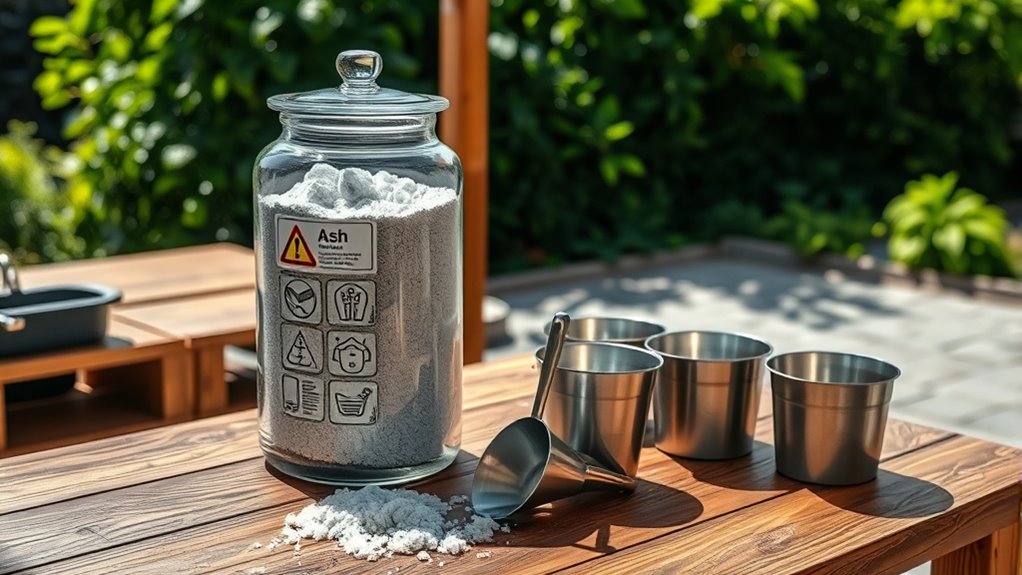
Proper disposal of wood ash is essential to minimize environmental impacts and guarantee safety. When managed correctly, you help protect air quality by preventing dust emissions that can contribute to pollution. Always ensure ash is cool before handling to avoid accidental fires or release of harmful particles into the air. Use secure, designated disposal sites or incorporate ash into compost or soil amendments in moderation, avoiding over-application that could leach harmful substances. Proper containment and disposal methods prevent ash from contaminating water sources or soil, reducing pollution risks. Following these best practices not only safeguards the environment but also promotes responsible waste management. By staying mindful of air quality and pollution prevention, you contribute to a cleaner, safer community and a healthier planet.
Tips for Storing and Managing Ash Safely
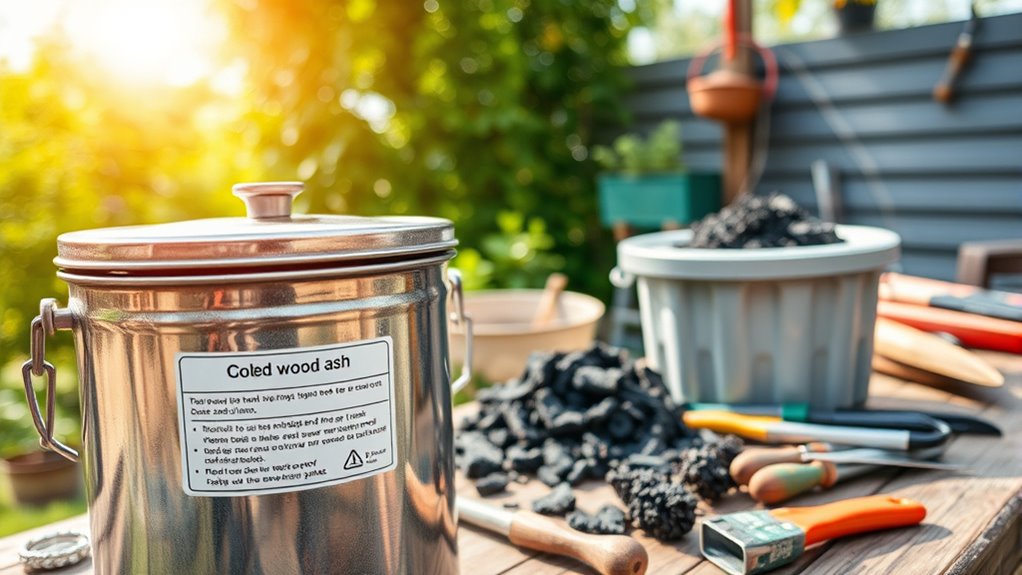
To store and manage ash safely, you should always keep it in a heat-resistant, sealed container until it is completely cool. This prevents accidental fires and reduces ash toxicity risks. Use sturdy storage containers made of metal or fireproof materials to avoid leaks or spills. Here are some tips to consider:
- Ensure the container is airtight to contain dust and prevent moisture.
- Label the container clearly as “Ash” to avoid confusion.
- Store away from flammable materials and direct sunlight.
- Regularly inspect containers for signs of deterioration or leaks.
Proper storage helps minimize health hazards and environmental impact. Always remember, ash toxicity can pose risks if mishandled, so safety and vigilance are key.
Frequently Asked Questions
Can Wood Ash Be Used in Compost Bins Safely?
You can use wood ash in your compost bin, but do so carefully. It helps with pH adjustment, balancing acidity, and can act as a pest deterrent. Just remember to add ash sparingly, as too much can raise the pH too high, harming your compost. Mix it well, and avoid using ash from treated or painted wood. Proper use guarantees safe, beneficial composting while minimizing risks.
How Long Does Wood Ash Last Before It Degrades?
Think of wood ash as a silent guardian, preserving its essence like a keepsake. Typically, ash preservation lasts about 6 to 12 months before it begins to degrade, influenced by moisture and exposure. The degradation timeline varies, but if kept dry and sealed, ash remains potent longer. Regularly check for signs of deterioration, ensuring your ash stays useful and safe for reuse or disposal.
Is Wood Ash Suitable for All Types of Plants?
You might wonder if wood ash suits all plants. While it can help with pH adjustment and even act as a pest repellent, it’s not ideal for every type. Some plants prefer acidic soil, so adding ash could harm them. Always test your soil first, and use ash sparingly. For best results, research your specific plants’ needs and avoid overusing ash to prevent soil imbalance.
What Are the Signs of Excess Ash in Soil?
Excess ash in soil is like a warning bell, signaling trouble ahead. You might notice plant toxicity symptoms like yellowing leaves, stunted growth, or dead patches. Soil contamination can occur if ash accumulates, raising pH levels too high and harming plants. Keep an eye on these signs to prevent damage. Regular testing helps guarantee your soil remains healthy and free from excess ash, protecting your garden’s vitality.
How Do I Tell if Ash Is Still Hot After Disposal?
To check if ash is still hot after disposal, you should perform temperature testing carefully. Use an infrared thermometer or a metal probe to gauge the temperature from a safe distance or with protective gloves. Always follow safety precautions by wearing gloves and eye protection. If the ash feels warm or you see smoke, it’s still hot. Wait until it cools completely before handling or disposing of it further.
Conclusion
Handling wood ash is like tending a quiet ember—careful and respectful. By understanding its makeup, following safety tips, and exploring reuse options, you turn a simple byproduct into a valuable resource. With mindful disposal and creative reuse, you can keep your home and environment safe, like tending a garden of opportunities waiting to bloom. Embrace these practices, and let your wood ash become a silent, yet powerful, ally in your sustainable journey.

